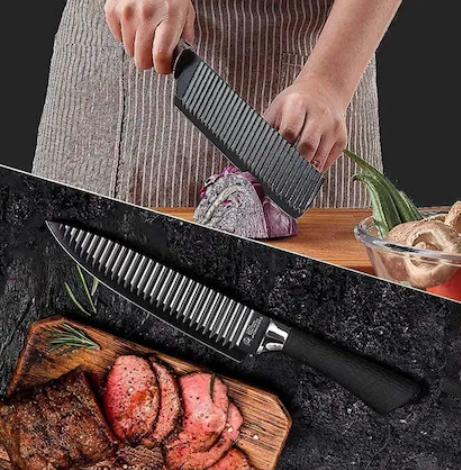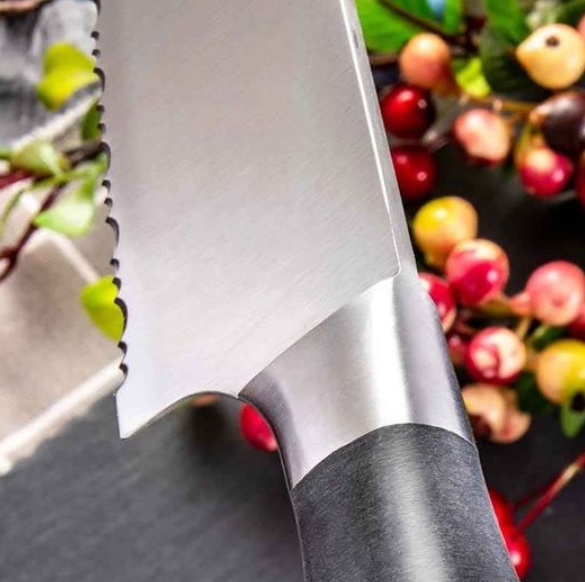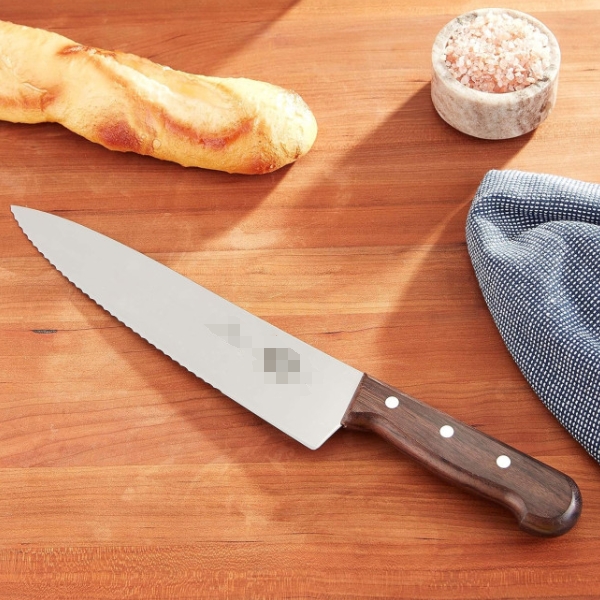

Views: 222 Author: Ella Publish Time: 2025-04-19 Origin: Site








Content Menu
● Types of Kitchen Knives for Vegetables
>> Chef's Knife
>> Nakiri Knife
>> Paring Knife
● How to Choose the Best Knife for Cutting Vegetables
● Knife Skills: Techniques for Cutting Vegetables
● Advanced Tips: Maximizing Knife Performance
● Care and Maintenance of Vegetable Knives
● Video Tutorials: Mastering Vegetable Chopping
>> Mastering Vegetable Chopping Like a Chef
>> Knife Skills – Slicing and Rocking Method
>> Essential Knife Skills Every Home Cook MUST Know
● FAQ: Top 5 Questions About Vegetable Knives
>> 1. What is the best all-purpose knife for cutting vegetables?
>> 2. Why is a Nakiri knife recommended for vegetables?
>> 3. How do I keep my vegetable knife sharp?
>> 4. What's the difference between a Santoku and a chef's knife?
>> 5. Can I use one knife for all my vegetable prep?
Choosing the right kitchen knife for cutting vegetables can transform your cooking experience—making prep work faster, safer, and more enjoyable. With a variety of knife styles on the market, each designed for specific tasks, it's essential to know which knife best suits your needs, how to use it effectively, and what features to look for. In this comprehensive guide, we'll explore the top contenders for the best vegetable knife, compare their strengths, provide expert tips, and answer frequently asked questions.

Vegetables are the foundation of countless recipes, from hearty stews to crisp salads. But even the freshest produce can be ruined by the wrong knife—think jagged tomato slices or bruised herbs. The right knife ensures clean, precise cuts, preserves flavor and texture, and makes prep work a pleasure rather than a chore.
Using the correct knife for cutting vegetables isn't just about convenience—it's about safety, efficiency, and the quality of your finished dish. A sharp, well-designed knife minimizes cell damage, preserves the vegetable's nutrients and appearance, and reduces the risk of slipping and injury.
A dull or inappropriate knife can crush delicate vegetables, causing them to lose moisture and flavor. It can also lead to uneven cuts, which affect cooking times and presentation. Moreover, a poorly balanced or uncomfortable knife can cause fatigue or even accidents during extended prep sessions. In contrast, a knife designed for vegetable work glides through produce effortlessly, making every slice uniform and every meal more appealing.
Let's break down the most popular knives for vegetable prep, highlighting their unique strengths and ideal uses.
The classic chef's knife is a staple in both home and professional kitchens. Typically 8 inches long with a curved blade, it excels at a variety of tasks—from mincing garlic to slicing carrots or dicing onions.
- Best for: All-purpose vegetable prep, chopping, slicing, dicing
- Key features: Curved edge for rocking motion, comfortable handle, balanced weight
A chef's knife is the workhorse of the kitchen and is especially valuable for cooks who want one tool to handle most tasks. Its versatility extends beyond vegetables, making it a sound investment for any kitchen.
Example: Mac Knife Professional 8-Inch Hollow Edge Chef Knife—praised for its sharpness, balance, and ability to make clean cuts through everything from tomatoes to sweet potatoes.
The Nakiri is a Japanese knife designed specifically for vegetables. Its straight, flat blade and squared-off tip make it ideal for push-cutting and achieving ultra-thin, even slices.
- Best for: Precise, thin slicing of vegetables, push-chopping, fine dicing
- Key features: Straight edge, rectangular blade, excellent knuckle clearance, minimizes bruising
The Nakiri's design allows for full blade contact with the cutting board, which is perfect for slicing through firm vegetables like carrots, cucumbers, and potatoes without the need for a rocking motion.
Example: Messermeister Olivia Elite 6.5" Nakiri Knife—lauded for its ability to slice cleanly through tomatoes, shallots, and even dense sweet potatoes with little effort.
The Santoku, another Japanese favorite, translates to “three virtues”—slicing, dicing, and mincing. It features a straight edge and a rounded tip, making it versatile and easy to handle.
- Best for: Slicing, dicing, mincing a wide range of vegetables
- Key features: Fluted (granton) edge to prevent sticking, lightweight, balanced
The Santoku's thinner blade makes it ideal for precision work, and its granton edge helps prevent vegetables from sticking to the blade, which is particularly useful when working with starchy produce like potatoes.
Example: Santoku Knife 7"—great for slicing through tough-skinned vegetables and producing uniform cuts.
Small but mighty, the paring knife is perfect for precision tasks—peeling, trimming, and working with smaller vegetables.
- Best for: Peeling, trimming, delicate work with small vegetables
- Key features: Short blade (3-4 inches), sharp tip, easy maneuverability
The paring knife is indispensable for tasks that require control and delicacy, such as removing eyes from potatoes or coring tomatoes.
Example: Paring Knife 3.8"—ideal for shallots, garlic, and intricate vegetable prep.
The utility knife sits between the chef's knife and paring knife in size, usually around 5-6 inches. It's a great all-rounder for smaller vegetables or when a chef's knife feels too large.
- Best for: Slicing medium-sized vegetables, trimming, sandwich prep
- Key features: Narrow blade, pointed tip, versatile
A utility knife is particularly handy for slicing tomatoes, cucumbers, and other medium-sized produce.
The vegetable cleaver, or Chinese chef's knife, features a broad, rectangular blade. Despite its intimidating appearance, it's designed for precision slicing and dicing rather than heavy chopping.
- Best for: Slicing, dicing, scooping up chopped vegetables
- Key features: Wide blade, thin edge, excellent for large volumes
The wide blade can also be used to transfer chopped vegetables from the board to the pan, making it a favorite in many Asian kitchens.

When selecting a vegetable knife, consider the following factors:
- Blade Shape: Straight edges (Nakiri, Santoku) are best for push-cutting and thin slices. Curved blades (Chef's knife) excel at rocking motions.
- Blade Material: Stainless steel is durable and easy to maintain. High-carbon steel holds an edge longer but requires more care to prevent rust. Ceramic blades are ultra-sharp but can chip easily.
- Handle Comfort: Look for ergonomic handles that provide a secure grip and balance—especially important for long prep sessions.
- Weight and Balance: A well-balanced knife reduces fatigue and improves control. Some cooks prefer a heavier knife for power, while others like lighter blades for agility.
- Intended Use: Match the knife to your most common vegetable prep tasks. For all-purpose use, a chef's knife or Santoku is ideal; for precision, choose a Nakiri or paring knife.
- Maintenance Needs: Consider how much time you're willing to spend sharpening and caring for your knife. Some materials and blade shapes are easier to maintain than others.
- Budget: High-quality knives can be an investment, but even mid-range options can offer excellent performance if chosen wisely.
Mastering knife skills is just as important as choosing the right blade. Here are essential techniques for vegetable prep:
- Chef's Knife: Use a rocking motion for chopping herbs or mincing onions—keep the tip of the blade on the board and move the handle up and down.
- Santoku/Nakiri: Use a push-cutting motion—move the blade straight down and forward for clean, even slices.
- Dicing: Cut the vegetable into planks, then sticks, then cubes for uniform pieces.
- Julienne: Slice into thin, matchstick-like strips for salads or stir-fries.
- Paring Knife: Use for peeling skins, removing blemishes, or creating decorative cuts.
- Chiffonade: Stack leafy greens, roll them tightly, and slice into thin ribbons.
- Brunoise: Start with julienne strips, then dice into tiny cubes for garnishes or fine salads.
- Oblique Cut: Rotate the vegetable after each diagonal slice for a decorative, angled appearance—ideal for carrots in stir-fries.
- Tourne: Create barrel-shaped pieces for elegant presentations, using a paring knife for precision.
- Keep Your Knife Sharp: Regular honing and periodic sharpening are crucial. A dull knife is more dangerous than a sharp one, as it requires more force and is prone to slipping.
- Use the Right Cutting Board: Choose wood or plastic boards to preserve your knife's edge. Avoid glass or stone surfaces, which can quickly dull blades.
- Grip Matters: Use a pinch grip—hold the blade between your thumb and forefinger for optimal control, rather than just gripping the handle.
- Mind Your Fingers: Practice the “claw” technique, tucking your fingertips under and guiding the knife with your knuckles.
- Don't Use Your Knife for Everything: Avoid using your vegetable knife to cut bones, frozen foods, or open packages, as this can damage the blade.
Proper care ensures your knife stays sharp and safe:
- Hand Wash Only: Avoid dishwashers, which can dull blades and damage handles.
- Dry Immediately: Prevent rust and stains by drying your knife after washing.
- Regular Sharpening: Use a honing rod or whetstone to maintain a sharp edge.
- Store Safely: Use a knife block, magnetic strip, or blade guard to protect the edge and prevent accidents.
- Oil Carbon Steel Blades: If you use a high-carbon steel knife, apply a thin layer of food-safe oil after cleaning to prevent rust.
- Check for Damage: Regularly inspect your knife for chips, cracks, or loose handles, and address any issues promptly.
Chef Dennis demonstrates proper knife selection and cutting techniques for bell peppers, broccoli, onion, and avocado. Learn dicing, slicing, and mincing methods to elevate your prep skills.
Chef Garrett explains forward cutting and rocking motions, showing how to slice zucchini and green onions efficiently and safely.
Learn the claw grip, julienne, and oblique cutting techniques for a variety of vegetables, ensuring uniform pieces and professional results.
The best kitchen knife for cutting vegetables depends on your cooking style, preferred techniques, and the types of vegetables you prepare most often. For all-purpose use, a high-quality chef's knife or Santoku is indispensable, offering versatility, comfort, and precision. For those who prioritize ultra-thin, even slices and minimal bruising—especially for salads or Japanese cuisine—the Nakiri is unmatched. Don't overlook the paring knife for delicate, detailed work.
Investing in a sharp, well-balanced knife and mastering proper cutting techniques will not only make your prep work more efficient but also enhance the flavor, texture, and appearance of your dishes. Remember to care for your knives with regular sharpening and safe storage to ensure they last a lifetime.

The chef's knife is the most versatile option for cutting vegetables, capable of handling everything from mincing herbs to slicing squash. Its curved blade allows for a rocking motion, making it ideal for a wide range of tasks.
The Nakiri knife's straight, flat blade is designed specifically for push-cutting vegetables. It produces clean, even slices with minimal bruising, preserving flavor and texture—especially important for salads and delicate produce.
Regularly hone your knife with a honing rod and sharpen it with a whetstone or professional service as needed. Always hand wash and dry immediately to prevent rust and maintain the blade's edge.
The Santoku has a straight edge and rounded tip, making it excellent for slicing, dicing, and mincing with a push-cutting motion. The chef's knife has a curved blade, suited for rocking motions and a broader range of tasks.
While a chef's knife or Santoku can handle most tasks, specialized knives like the Nakiri or paring knife offer better results for specific jobs—such as ultra-thin slicing or precision work. Using the right knife improves efficiency and safety.
[1] https://www.foodandwine.com/best-vegetable-knives-8400300
[2] https://www.alamy.com/stock-photo/vegetable-knife.html
[3] https://www.youtube.com/watch?v=5WhiN7u7FZ8
[4] https://thriftyniftymommy.com/best-knives-for-cutting-vegetables/
[5] https://sharpedgeshop.com/blogs/knife-types/nakiri-the-knife-for-cutting-vegetables
[6] https://www.youtube.com/watch?v=PLk2NKzE6R0
[7] https://www.seriouseats.com/best-nakiri-knives-6931056
[8] https://www.youtube.com/watch?v=-al-bs737fw
[9] https://madeincookware.com/blogs/knife-to-cut-vegetables
[10] https://www.chefs-edge.com/blogs/knife-information/the-best-knife-for-cutting-vegetables
[11] https://www.nytimes.com/wirecutter/reviews/the-best-chefs-knife-for-most-cooks/
[12] https://www.knivesandtools.com/en/ct/buying-guide-what-do-you-want-to-cut-kitchen-knives.htm
[13] https://yakushiknives.com/blogs/yakushi-blog-all-thing-knives/best-knife-for-cutting-vegetables
[14] https://www.reddit.com/r/Cooking/comments/13x5vp3/can_someone_recommend_me_a_good_knife_for_cutting/
[15] https://www.knivesandtools.com/en/ct/buying-guide-vegetable-knives.htm
[16] https://www.istockphoto.com/photos/vegetable-knife
[17] https://www.shutterstock.com/search/vegetables-knife
[18] https://www.istockphoto.com/photos/chef-chopping-vegetables
[19] https://www.freepik.com/free-photos-vectors/vegetable-knife
[20] https://www.shutterstock.com/search/knife-cutting-vegetables
[21] https://stock.adobe.com/search/images?k=chef+chopping+vegetables
[22] https://www.youtube.com/watch?v=PnWDTexgbAM
[23] https://unsplash.com/photos/person-cutting-vegetables-with-knife-yWG-ndhxvqY
[24] https://www.youtube.com/watch?v=p28wMbunulQ
[25] https://www.youtube.com/watch?v=mnJewFAksAQ
[26] https://www.youtube.com/watch?v=QJt-WLG3FWg
[27] https://www.youtube.com/watch?v=SDv2yO5XOD0
[28] https://www.reddit.com/r/Tiktokhelp/comments/13tnbr0/can_you_show_knives_while_cutting/
[29] https://www.youtube.com/watch?v=OH3czHJdeSE
[30] https://www.reddit.com/r/chefknives/comments/6w3bwr/best_knife_for_vegetables/
[31] https://ohmyveggies.com/a-guide-to-knives-and-cutting/
[32] https://www.kitchenknifeforums.com/threads/help-buying-new-knife-home-use-mostly-for-vegetables.44000/post-648949
[33] https://forums.egullet.org/topic/121375-a-knife-for-vegetables/